Time:2025-05-16 14:53:17 Number of Clicks:
According to recent reports by Global Market Insights, the global bulk material handling equipment market has reached $21.7 billion, with a compound annual growth rate of 4.5%. In scenarios such as ports, mines, and thermal power plants, material handling costs account for 12%-18% of total operational expenses. As the core equipment of bulk material storage systems, stackers are driving industry efficiency transformations through automation and modular technological upgrades.

Utilizing a three-row roller bearing structure with a load capacity of 800 tons, the bearing sealing system in high-salt-spray environments (C5 corrosion grade) employs a multi-layer labyrinth design combined with lithium-based grease to resist salt penetration.
The truss structure is welded from Q690D high-strength steel plates with a yield strength of 690 MPa, equivalent to 2.3 times that of ordinary construction steel. The telescopic travel design accounts for thermal deformation, with boom extension errors in extreme cold regions kept below 2 mm using temperature compensation devices. Zoomry Heavy Industry's ZR-280 model features a variable cross-section design, tapering from 1.8 m to 0.9 m at the tip, ensuring rigidity while reducing wind load by 40%.
The dual-action hydraulic cylinder drive system is equipped with an emergency accumulator, maintaining basic functionality for 30 minutes during power outages. The hydraulic oil used is wide-temperature HM46 (-40°C to 90°C), with the oil temperature control system keeping the hydraulic station temperature ≤65°C under extreme heat. An 18° luffing angle enables material projection distances of up to 45 meters, meeting the needs of 100,000-ton stockyards.
The adjustable rail gauge (6-12 meters) accommodates various geological conditions:
Stacker material input is achieved through two typical feeding methods. In belt conveyor systems, the main conveyor belt adopts a 2000 mm width design with speed stabilized at 4.5 m/s, achieving maximum throughput of 8000 t/h. Material transfer chutes use 15 mm thick ceramic liners to reduce impact wear, with surface roughness Ra≤1.6 μm polishing reducing material sliding resistance by 35%. Hydraulic tensioning devices serve as emergency brakes, completing belt locking within 0.5 seconds with deceleration controlled within the safe range of 0.3-0.5 m/s². For truck unloading, 80 m³ receiving hoppers with 300 mm grid spacing intercept oversized particles, while dual-axis eccentric vibrators generate 8000 N excitation force, ensuring uniform feeding at 1800 t/h even for sticky materials with 15% moisture content.
Stacker positioning follows industrial engineering principles, with the slewing center maintaining a golden ratio of 1.5 times the maximum boom extension length from stockyard edges, achieving theoretically optimal coverage. Equipment foundations are elevated 1.2 meters above ground level, combined with 600 mm wide × 400 mm deep perimeter drainage systems to withstand century-level storms. Laser surveying precisely controls safety distances, maintaining 30 m separation from reclaimers, with laser collision warning systems automatically triggering audible/visual alarms and speed reduction when distances decrease to 25 m.
The intelligent control system establishes a three-layer technical loop: The perception layer uses 3D LiDAR to capture 10,000 point cloud data points per second for precise pile contour reconstruction, while vibration sensors sample at 20 kHz to capture bearing frequency characteristics. The decision layer employs Bézier curve algorithms to generate optimal stacking paths and establishes mathematical models of boom motion envelopes to predict interference risks. The execution layer uses proportional valves for precise hydraulic cylinder speed control (0.01-2 m/s stepless adjustment), with SEW helical gear reducers delivering smooth torque at 187:1 ratio and over 96% transmission efficiency. The system achieves cross-layer data communication via OPC UA protocol, with control command transmission delays kept below 50 ms.
For any questions about stacker functions, please contact us using the following information:
For port space constraints, Zoomry has developed mobile shiploaders integrating stacker boom structures with ship motion compensation technology. With 25 m telescopic range and free movement within 200 m shoreline, loading efficiency reaches 8400 t/h, effectively overcoming fixed stacker space limitations.
Copyright © 2002-2024 Zoomry Group Company Limited